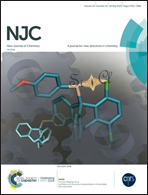Extractive/catalytic oxidative mechanisms over [Hnmp]Cl·xFeCl3 ionic liquids towards the desulfurization of model oils
Abstract
In this work, N-methyl-2-pyrrolidonium (NMP) was acidized using hydrochloric acid to obtain [Hnmp]Cl first, which was then reacted with FeCl3 to prepare a series of inexpensive tunable [Hnmp]Cl·xFeCl3 (x = 0.2–2.0) ionic liquids (ILs) for the extractive and oxidative desulfurization of model oils. The Lewis acidities of these ILs were tested by the Fourier transform infrared (FT-IR) method, which indicated that when the x value of [Hnmp]Cl·xFeCl3 was above 1.0, the ILs exhibited Lewis acidity. The extraction results showed that the acidification of NMP reduced its dissolubility ability toward dibenzothiophene (DBT) and its Lewis acidity played a determining role in extractive desulfurization. In the catalytic oxidation removal process of the DBT model oil in the presence of H2O2, electron paramagnetic resonance (EPR) and scavenger experiments showed that the hydroxyl radical (˙OH) plays a key role and the superoxide anion radical (O2˙−) has a minor function. [Hnmp]Cl·1.5FeCl3 IL showed excellent recycling performance, which was due to its high dissolving capacity (23 700 ppm) for dibenzothiophene-sulfone (DBTO2).
![Graphical abstract: Extractive/catalytic oxidative mechanisms over [Hnmp]Cl·xFeCl3 ionic liquids towards the desulfurization of model oils](/en/Image/Get?imageInfo.ImageType=GA&imageInfo.ImageIdentifier.ManuscriptID=C9NJ00691E&imageInfo.ImageIdentifier.Year=2019)


 Please wait while we load your content...
Please wait while we load your content...